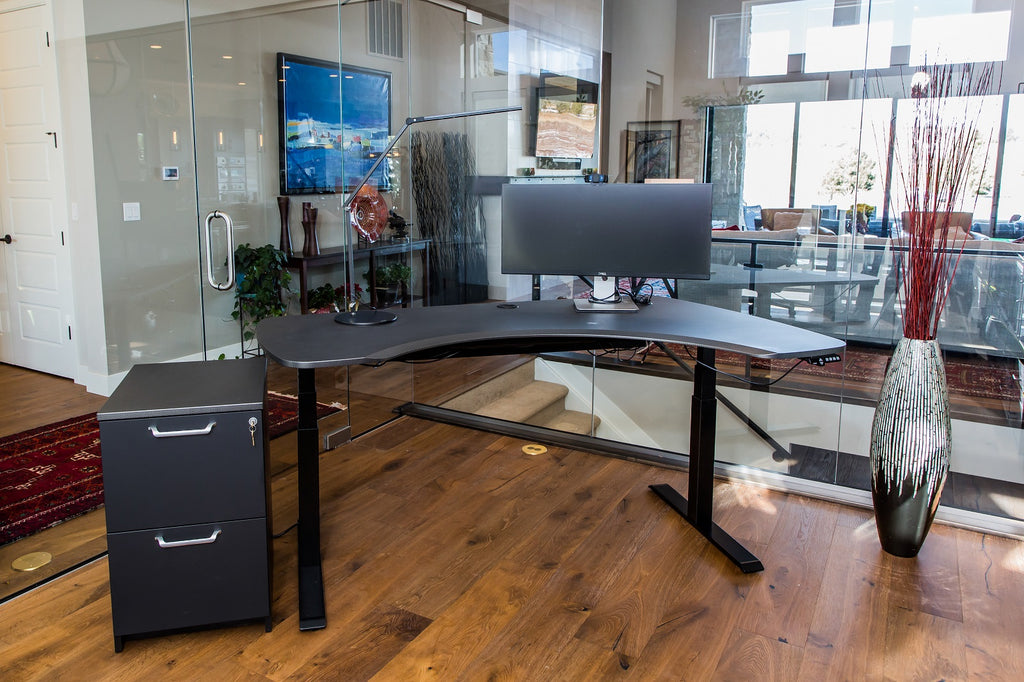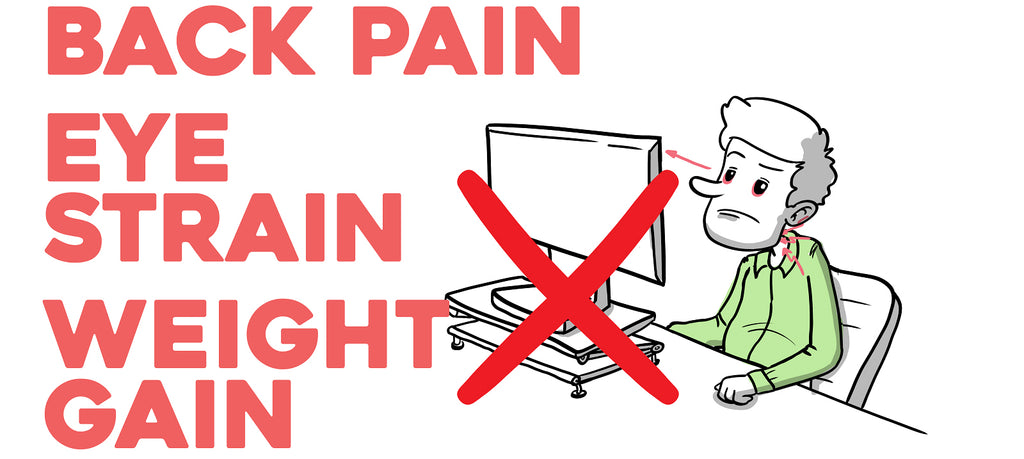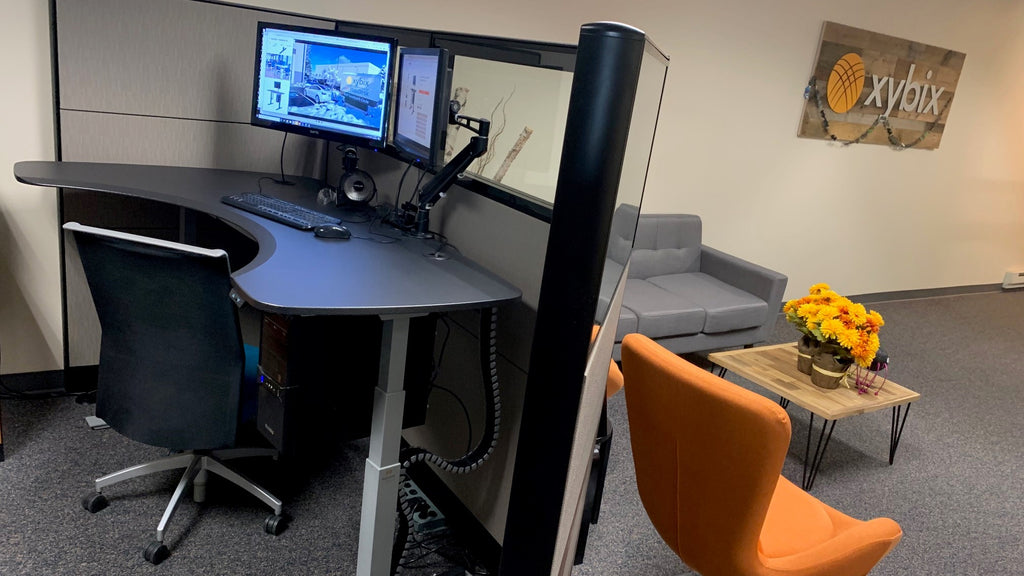
How long have standing desks existed? The answer may surprise you. The electric adjustable standing desk is a newer version but the history of standing desks goes all the way back to the 1400s with Leonardo Davinci not sitting down on the job. Thomas Jefferson also rocked one at the White House as his preferred method of working. No, these didn't plug into a wall with presets and Bluetooth that tracks your calories burned throughout the day but you get the idea.
Electric Adjustable Height Desk Basics
An sit-to-stand desk is an alternative type of workspace which allows the user to stay active while working. An electric standing desk is chiefly as its name implies: an electric motor-driven, adjustable desk which can be positioned at different levels for working.
The desk rises up and retracts back down at the desire of the worker, making a variety of heights available by the push of a button.

Health Benefits of Sit-Stand Desks
There are many health benefits associated with a sit to stand adjustable desk, including the ergonomic setups and the ability to move while standing. Employers and employees in the corporate setting can achieve a better balance of movement and activity during the workday. The purpose of the electric standing desk is manifold. Beyond the ability to move up and down, the desk allows for ideal matching to any sized employee - short or tall.
Three Phase Standing Desk Legs and Stability
The concept and mechanics are fairly simple for the adjustable desk. The legs of the desk are geared in such a manner that a small electric motor can move them up and down to position the work surface at the desired level. However, a three stage leg and two motor adjustable height desk provides a more stable work surface avoiding keyboard bounce and monitor shake. This means there is a motor for each leg and the steel legs have 3 sections that adjust. Less expensive standing desks have two stage legs and one motor that are less stable but also don't have the same range as three stage.
Will a Standing Desk Help My Back Pain?
Standing while working at a modified conventional desk is not a new concept. Throughout history, many prominent people were known to have used a standing-style desk for their creative endeavors.
The difference is that these resourceful people---inventors, writers, statesmen, and so forth---did not necessarily have improve their health as a motive for their ingenuity.
To answer the question, yes, standing desks will help your back pain. It will stop the hunch of pulling your shoulders forward and curving your spine. This is part of the motive behind today’s emphasis on standing while working at a desk are almost entirely driven by a need to preserve the health of the employee whose primary job requires extensive sitting.

Active = Alternating Between Sitting and Standing
Should you stand all day? No. The basic point of this is that the work surface, or desktop height, is adjustable so you can switch it up during the day and stay active. There is a significant difference between just a standing desk and an adjustable standing desk.
To expound on the historical point made above: these creative ancestors of ours who worked at a standing desk did not have an adjustable one. It was merely a desk at which they could stand rather than sit…one of a fixed height to accommodate them when working on their projects.
A fixed-height standing desk has some value. It provides the worker with an opportunity to stand rather than sit. But that’s essentially where the benefits end.
An adjustable desktop is designed for a specific purpose…to be adjustable to any desired height. And, the reasoning behind this idea brings us to the objective of ergonomics.
Ergonomics and Sit-Stand Desks
The term ergonomics grew out of the industrial revolution and was the government’s attempt to focus on helping factory workers avoid injuries which generally resulted from heavy lifting and bending.
Ergonomics moved into the office worker’s environment in the 1980’s as commerce continued to evolve.
Then, as more and more workers began to sit for longer durations performing their duties, the emphasis on ergonomics in the workplace increased.
When we entered the computer age and keyboarding for hours on end became normal, employees began to experience a condition known as Carpal Tunnel---problems with the hand and wrist. As a result, a national ergonomic standard was created for all office furniture.

Traditional Desks: One size doesn't fit all.
Studies were conducted and revealed that the typical office desk height (29”) did not provide a comfortable working position for over half of the workforce in the country.
Initial remedies were to adjust the height of the keyboard or redesign the keyboard completely.
But the push for ergonomically friendly work surfaces led to the development of adjustable desktops.
Brief Summary of Ergonomics
Without going into a history lesson on ergonomics, the development of the electric adjustable standing desk is the result of this effort to provide a safe and healthy working platform for the employee who sits for a living. At a minimum, the ergonomics of a desk should consider knee clearance, viewing angles, reach zones, focal depth, and keyboard surface height.
Designed to fit the employee---any employee.
Ergonomics is the practice of designing equipment, processes, and systems to account for and enable effective and safe human interaction with these items.
So, the logic behind a desktop being adjustable is understandable. First of all, it provides an opportunity to lift the desktop anywhere from a normal sitting position to a standing position.
But it doesn’t end there: the key is the term adjustable. The desktop can be adjusted to match your height perfectly.This is the true ergonomic value of an electric standing desk.
Adjusts to your perfect position.
With an adjustable sit-to-standing desk there are two key points of adjustment to keep in mind when considering which model or type of desk works best for you.
First is the height of the desktop itself and its relationship to your arms, shoulders, hands, and wrists as you work at the desk.
The second position is the height of the monitor relative to your head, neck, and shoulders. An adjustable monitor arm is essential in allowing you to set the precise height and distance of the monitor.
There are many guides and diagrams to show you the proper positioning for your height, but comfort is the underlying factor that drives the whole ergonomic concept. If it’s not comfortable, it’s probably not good for you.

Extra benefits of an adjustable desk
One additional benefit of an electric standing desk is that, as the desktop raises and lowers, all of your work moves with it: your paperwork, reference material, phone, coffee cup…whatever you keep at your desk while you work. This can improve efficiency as well as eliminate unnecessary bending and reaching.
Another fundamental point to be made about the electric standing desk is simply that it is electrically operated. It makes adjusting the desk quicker and easier than a manually adjusted desktop, which often tends to be heavily geared and a challenge to easily move…especially when the desk is loaded down with your work materials.
And just one more advantage of an electrically adjustable standing desk is this. When we sit or stand for a period of time, we tend to squirm around a bit…that is change our sitting or standing posture to alleviate strain and tension. The electric standing desk is ideal for tweaking the height to match these changes in posture.
Keep in mind, these ergonomic requirements and features apply to both the sitting and standing positions---hence, the significance of being adjustable throughout the full range of motion.
But just being able to sit and stand in ergonomic comfort is not all there is to it.
Expending energy: Exercise at your Desk
Dr. James Levine of Minnesota’s Mayo Clinic is an often-quoted specialist on obesity and its relationship to inactivity. He stated in one of his reports that “one obvious consequence of chair-based living is that sitters expend fewer calories than do movers.”
He points out that just standing is not the answer. While standing, it’s important to move around in order to create energy and burn calories.
While standing and working, try moving around as you work. Merely shuffling your feet and changing posture is a good place to start.
But for really effective body movement, check out some of the exercise routines specifically designed for the worker who is standing at his desk during the day.
A quick Google for the best standing desk exercises will provide you a long list of the 10 Best, the 7 Best, the Ultimate Best exercises to do at your desk. More than likely, if your company provides you with an electric standing desk, they will also have several exercise programs in place already.
And, just as a side note; there are also routines to do while sitting at your desk as well. You can turn your entire workday into an exercise workout---just think of the benefits.
The exercises are principally about flexing and stretching. But the whole point, according to Dr. Levine, is to simply move rather than stand stationary. Any movement is better than no movement at all according to his research. And proper posture at work is vital for your overall mood and health.
Achieve a sitting and standing balance: the best thing to do.
It’s important to understand that you need to achieve a balance in your workday. It’s not about standing all day as opposed to sitting all day. It’s about having the opportunity to stand when desired and then, to sit again when tired. Finding that balance is important.
Start out slowly, standing for ten minutes or so, then sit again. Keep building up your stamina and eventually, you will find that perfect balance.
MojoDesk. Part of a Healthy Workday.
But the key to all of this is to listen to what your body is telling you. With an electric standing desk designed and built by MojoDesk, you can respond to whatever your body demands and adjust your work environment to accommodate it.
Regardless, whether sitting or standing, an ergonomically friendly work desk, that is completely adjustable to fit your needs, is critical.


